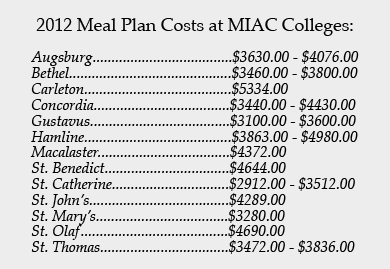The Evelyn Young Dining Room is the hub of life at Gustavus. Open from 7 a.m. to 11 p.m. the majority of the week, it is a center for student interaction, nutrition and escape from the demands of the classroom. The pillars that stretch from floor to ceiling are each dedicated to a core value of the institution—community, excellence, service, justice and faith—and similarly embody the holistic view the Gustavus Dining Service holds towards the dining experience they provide.
Philosophy and Gender, Women and Sexuality Studies Professor Lisa Heldke ’82 is a member of Kitchen Cabinet, an advisory body to the Dining Service, has written and edited numerous essays and articles on the philosophy of food. Her response to an investigative article on dining costs at Gustavus reflected this holistic view in a desire to broaden the discussion to include the philosophy behind such choices.
“A story that just focuses on dollars and cents panders too much to the kind of simple consumerist idea that ‘stuff should be cheap,’ no matter how it gets produced. If the dining service is really a part of the educational climate of this institution, then we need to tell a more complicated story than that,” Heldke said.
In seeking to understand this year’s price increase on food items in the Caf, a more complicated story must include the rationale behind the decision, the reality of market costs and the balance between affordable and ethical.
Having refrained from any significant price increases over the past three years despite market increases of 15-25 percent, there became a clear need for price adjustment. That adjustment was made this fall semester as prices were increased to reflect the 5-10 percent increase in wholesale goods encountered in just the previous year.
As a result, many students were surprised when they reached the end of September to find themselves paying for meals with their October funds. This dilemma may be rooted in the percent increase of meal plans. Last year a student would have paid $3100 for the smallest meal plan (10 to 13 meals per week), and this year the cost is $3170, a 2.3 percent increase. This change does not adequately reflect the 5-10 percent cost adjustment and therefore has made it difficult for students to adjust to the new food item prices because they are finding it more difficult to stay within their meal plan budget.
Dining Service and Book Mark Director Steve Kjellgren ’86 stresses that there are no hidden costs to eating at the Caf; there is merely an educational process to understand the complete cost of an entrée or a side dish.
“There are no hidden costs. A hamburger, for instance, is priced at the register to cover the cost of the burger, bun, lettuce, tomato, onion, cheese, ketchup, mayo, mustard, napkin, washing the plate, heating the griddle, hot steam table and the water that goes into it, the person who orders the food, stocks it, takes it out of storage, cooks it, serves it, and then cleans the grill and steam table and takes out the trash. That’s it. Nothing hidden,” Kjellgren said.
Indeed one may refer to these steps as hidden costs because they are not immediately apparent when regarding a simple hamburger on your plate, yet they remain very real costs. To provide some transparency as to where some of these operational costs come from, a student may look to their meal plan contract where it reads: “The cost of each plan includes a $225.00/semester facilities, staff and administrative support fee.” This is the portion of each student’s meal plan that helps pay for utilities and other production costs incurred from their dining experience.
The term “dining experience” has come to define the Dining Service philosophy at Gustavus and direct their attention to continual improvement and consumer satisfaction. Dining Service Supervisor Paul Matzke explained that his initial transition from the restaurant industry to his position at Gustavus was difficult for this very reason because he was no longer working to make a profit. The Dining Service was nothing like the restaurant industry and focused on the students rather than monetary gain.
“We’re not here to make a profit. We’re here to serve students and break even. Breaking even is great,” Matzke said. “Prices reflect purchasing cost. Higher priced items, like salmon or steak, fluctuate with purchasing price, so if we pay less, we’ll charge less.”
Kjellgren agreed that the Dining Service seeks to place student satisfaction and affordability first while striving to embody the institution’s values.
“What we do at Gustavus is light years ahead of what the rest of higher education is doing in terms of food ethics, consumer education and waste reduction. I’m awfully proud of our college and our concern and stewardship of the food system,” Kjellgren said.
This return to the base philosophies of quality, stewardship, and student service is deliberate to allow for student voice and ethical choice. College employees seek to meet the expectations of the students while bearing in mind the realities of markets and food costs. Active participation is necessary for students to expand their knowledge of their choices and their opportunities to implement change within the Dining Service.
“We like that if you have a suggestion or complaint that you come to us and meet with us face to face,” Matzke said. “We don’t want you to wait.”
Costs have risen and meal plans have changed, yet the philosophy of the Dining Service has stayed the same. Because Gustavus runs Dining Service independently from an outside contractor, students are welcome to determine the course of their personal collegiate dining experiences: to question, reflect and initiate change.
